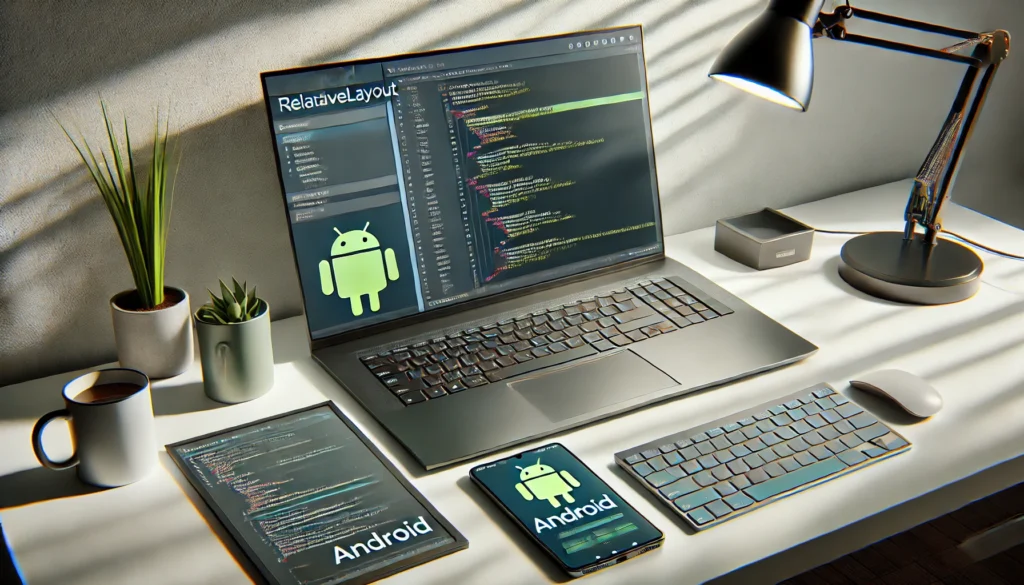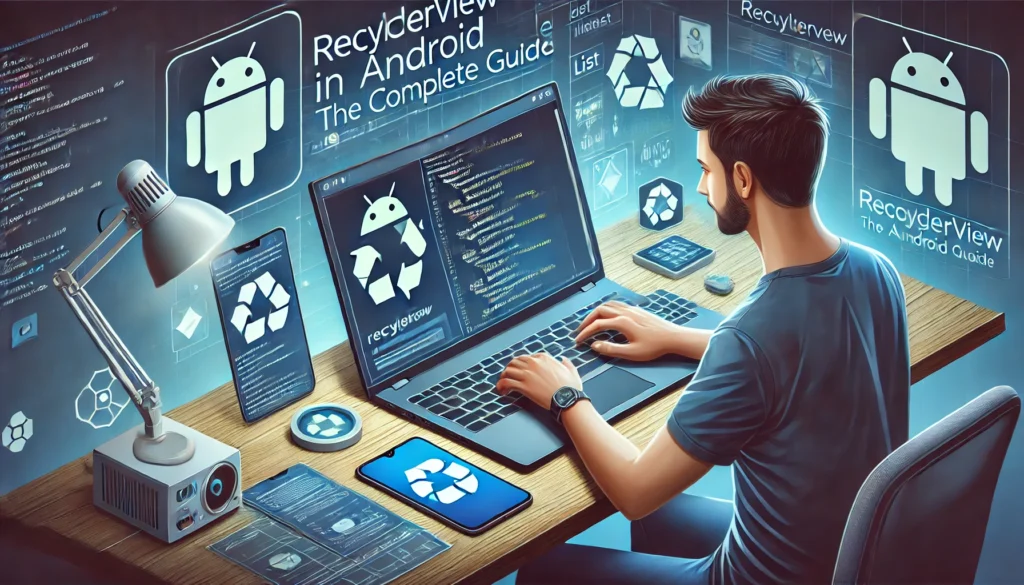Hello guys, in this tutorial we will learn how to use Relative Layout in Android. Relative Layout is the main layout into android using XML. It is used to align the layouts relatively to each other.

Introduction
Android provides various layout managers to arrange UI elements in an app, and one of the most commonly used is RelativeLayout. It is a flexible ViewGroup that allows developers to position child views relative to each other or relative to the parent container.
In this guide, we will explore what Relative Layout is, how it works, its advantages, and how to use it effectively in Android development.
What is Relative Layout in Android?
RelativeLayout is a ViewGroup in Android that arranges its child views relative to each other or the parent layout. This makes it more flexible and efficient than linear layouts when designing complex UI structures.
Key Features of RelativeLayout
✅ Flexible Positioning – Align views relative to each other (above, below, left, right).
✅ Optimized for Complex UI – Better than nested LinearLayouts for performance.
✅ Dynamic Layout Adjustments – Works well for different screen sizes.
✅ Fewer Nested Layouts – Reduces hierarchy depth, improving rendering speed.
Attributes Used in RelativeLayout
To position elements in a RelativeLayout, Android provides several attributes:
| Attribute | Description |
|---|---|
android:layout_alignParentTop="true" | Aligns the view at the top of the parent. |
android:layout_alignParentBottom="true" | Aligns the view at the bottom of the parent. |
android:layout_alignParentLeft="true" | Aligns the view to the left of the parent. |
android:layout_alignParentRight="true" | Aligns the view to the right of the parent. |
android:layout_above="@id/viewID" | Positions the view above the specified view. |
android:layout_below="@id/viewID" | Positions the view below the specified view. |
android:layout_toLeftOf="@id/viewID" | Positions the view to the left of the specified view. |
android:layout_toRightOf="@id/viewID" | Positions the view to the right of the specified view. |
android:layout_centerHorizontal="true" | Centers the view horizontally. |
android:layout_centerVertical="true" | Centers the view vertically. |
android:layout_centerInParent="true" | Centers the view in both horizontal and vertical directions. |
Example of Relative Layout in Android
Here’s a simple example demonstrating how to use RelativeLayout in Android.
Step 1: Create a New Android Project
- Open Android Studio.
- Create a new project with Empty Activity.
- Open
activity_main.xmland replace its content with the following code.
Step 2: Implement RelativeLayout in XML
<RelativeLayout xmlns:android="http://schemas.android.com/apk/res/android"
android:layout_width="match_parent"
android:layout_height="match_parent">
<TextView
android:id="@+id/titleText"
android:layout_width="wrap_content"
android:layout_height="wrap_content"
android:text="RelativeLayout Example"
android:textSize="24sp"
android:textStyle="bold"
android:layout_centerHorizontal="true"
android:layout_marginTop="50dp"/>
<Button
android:id="@+id/myButton"
android:layout_width="wrap_content"
android:layout_height="wrap_content"
android:text="Click Me"
android:layout_below="@id/titleText"
android:layout_centerHorizontal="true"
android:layout_marginTop="20dp"/>
</RelativeLayout>Step 3: Handle Button Click in Java/Kotlin
Java Code (MainActivity.java)
package com.example.relativelayoutdemo;
import android.os.Bundle;
import android.view.View;
import android.widget.Button;
import android.widget.Toast;
import androidx.appcompat.app.AppCompatActivity;
public class MainActivity extends AppCompatActivity {
@Override
protected void onCreate(Bundle savedInstanceState) {
super.onCreate(savedInstanceState);
setContentView(R.layout.activity_main);
Button myButton = findViewById(R.id.myButton);
myButton.setOnClickListener(new View.OnClickListener() {
@Override
public void onClick(View v) {
Toast.makeText(MainActivity.this, "Button Clicked!", Toast.LENGTH_SHORT).show();
}
});
}
}Kotlin Code (MainActivity.kt)
package com.example.relativelayoutdemo
import android.os.Bundle
import android.widget.Button
import android.widget.Toast
import androidx.appcompat.app.AppCompatActivity
class MainActivity : AppCompatActivity() {
override fun onCreate(savedInstanceState: Bundle?) {
super.onCreate(savedInstanceState)
setContentView(R.layout.activity_main)
val myButton: Button = findViewById(R.id.myButton)
myButton.setOnClickListener {
Toast.makeText(this, "Button Clicked!", Toast.LENGTH_SHORT).show()
}
}
}Advantages of RelativeLayout
✅ More Efficient than LinearLayout – Reduces the need for nested layouts.
✅ Flexible UI Design – Allows precise positioning of elements.
✅ Dynamic Adjustments – Works well with different screen sizes.
✅ Better Readability – Less XML code compared to multiple nested layouts.
Disadvantages of RelativeLayout
❌ Complex Positioning – Large layouts can become difficult to manage.
❌ Higher Performance Cost – If too many views are positioned relatively, rendering may slow down.
❌ Less Modern – Newer layouts like ConstraintLayout offer better performance and flexibility.
RelativeLayout vs ConstraintLayout
| Feature | RelativeLayout | ConstraintLayout |
| Performance | ⭐⭐⭐ | ⭐⭐⭐⭐⭐ |
| Ease of Use | ⭐⭐⭐⭐⭐ | ⭐⭐⭐ |
| Nesting Required | ✅ Yes | ❌ No |
| Auto Resizing | ❌ No | ✅ Yes |
| Animation Support | ⭐⭐⭐ | ⭐⭐⭐⭐⭐ |
Although RelativeLayout is still widely used, ConstraintLayout is recommended for better performance and flexibility.
FAQs About RelativeLayout
1. When should I use RelativeLayout?
Use RelativeLayout when you need flexible UI positioning without deep nesting.
2. Is RelativeLayout still used in modern Android development?
Yes, but ConstraintLayout is now preferred for complex layouts due to its better performance.
3. Can I use RelativeLayout inside a ConstraintLayout?
Yes, you can nest different layouts inside each other based on design needs.
4. What is the main disadvantage of RelativeLayout?
Too many relative dependencies can slow down UI rendering, making ConstraintLayout a better choice.
Conclusion
RelativeLayout is a powerful and flexible layout that allows developers to position elements relative to each other. While it is still useful, ConstraintLayout is often preferred for modern UI development. Understanding RelativeLayout helps in designing efficient and user-friendly Android apps.
Start building your Android UI with RelativeLayout today! 🚀
See more about it from its official website.


